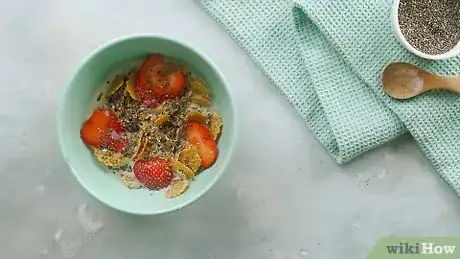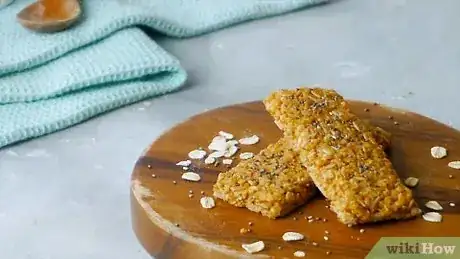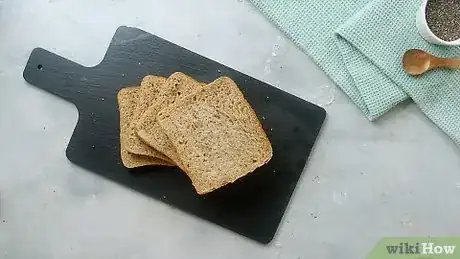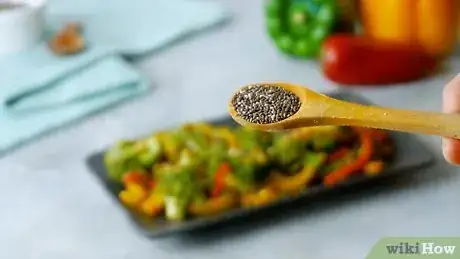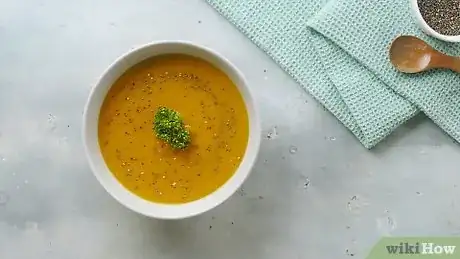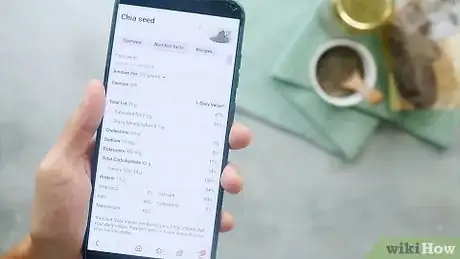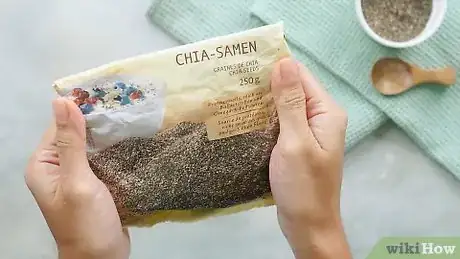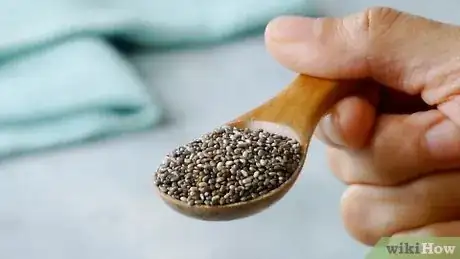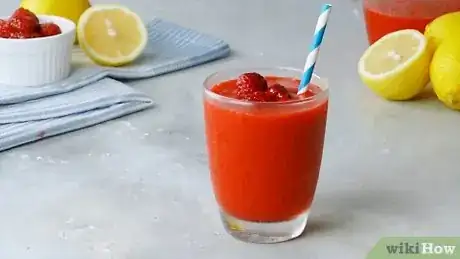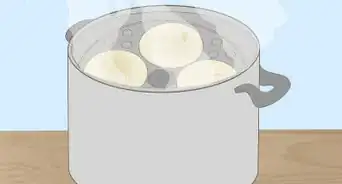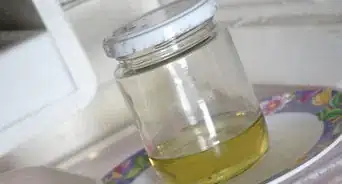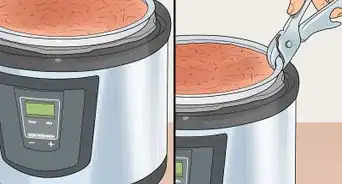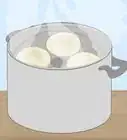This article was co-authored by Theresa Fitzpatrick, LMSW. Theresa Fitzpatrick is a Certified Holistic Health Coach and the Owner of Mind Your Body Holistic Coaching. She specializes in helping women lose weight and gain confidence. Theresa holds a Master of Social Work from Fordham University and received her Transformational Coach Certification from The Health Coach Institute.
There are 10 references cited in this article, which can be found at the bottom of the page.
wikiHow marks an article as reader-approved once it receives enough positive feedback. This article received 25 testimonials and 96% of readers who voted found it helpful, earning it our reader-approved status.
This article has been viewed 873,546 times.
Chia seeds are a popular health food that have been consumed for centuries, but have only recently gained popularity in the Western world. Because they mix easily into other foods and have little flavor of their own, they are easily incorporated into your usual meals. Read on to learn about the many ways you can eat chia seeds, from hiding them into your ordinary food to exploring new recipes for chia puddings or smoothies.
Steps
Eating Chia Seeds Uncooked
-
1Mix the chia seeds into oatmeal, yogurt, or other wet foods. One of the most common ways to eat chia seeds raw is to sprinkle them over or mix them into other dishes. Stir them in any wet food to turn the dry seeds gelatinous and mushy, which will help them blend into the food less obviously.
- Add chia to your breakfast by sprinkling 1 or 2 Tbsp (15 or 30 ml) of chia seeds over oatmeal, yogurt, or breakfast cereal.
- For a healthy snack or light lunch, stir 1 to 2 Tbsp (15 to 30 ml) of chia seeds into a cup of cottage cheese.
- Mix chia seeds into wet sandwich ingredients. Use tuna salad or egg salad for savory sandwiches, or peanut butter or hazelnut spread for sweet sandwiches.
-
2Sprinkle chia seeds over foods to keep the seeds crunchy. If the food is dry, the seeds will stay crunchy, which some people prefer. Even on wet foods, a sprinkling of seeds at the top may not form a gel if not mixed in.
- Sprinkle the seeds over any type of salad.
- Decorate pudding with a dash of chia seeds.
Advertisement -
3Hide chia seeds in raw one-dish meals. This is especially helpful if you have picky eaters in your household that may otherwise scoff at the notion of consuming these tiny seeds.
- Mix chia seeds into potato salad or cold pasta salads. Add 2 tbsp (30 mL) of chia seeds to a large serving bowl of potato or pasta salad and stir thoroughly.
-
4Make granola bars with chia seeds. Mix 2 Tbsp (30 mL) chia seeds into your favorite granola bar recipe. For a no-bake recipe, stir the seeds into 1 cup pitted, blended dates, 1/4 cup peanut butter or other nut spread, 1 1/2 cups rolled oats, 1/4 cup honey or maple syrup, and 1 cup chopped nuts.[1] Spread this mixture on a pan and harden in the fridge. You may toast the oats before adding to add a different flavor, or explore other granola bar recipes that require baking.
-
5Create flavored chia gelatin or jelly. Add chia seeds to pureed fruit. More chia seeds will create a gelatin, while fewer will create a jelly. You may need to experiment with different amounts until you find a ratio best suited to your type of fruit and preferences.
- Roughly speaking, 1 1/2 cups (375 ml) of pureed fruit and 1/2 cup (125 ml) chia seeds mixed together create a chunky jam.
Eating Chia Seeds Cooked
-
1Make chia seed porridge. Stir 1–2 tbsp (15–30 mL) of chia seeds into a cup (240 mL) of warm milk or any milk substitute. Let stand for 10–15 minutes until the mixture forms a gel, whisking occasionally to break up seed clumps, then eat cold or heat again before eating.[2] [3] The mixture alone is quite bland, so you may enjoy eating with sliced fruit, dried fruit, nuts, or honey. Add extra flavor with a pinch of cinnamon or sea salt if desired.
- 2 tbsp (30 mL) will make a thick porridge. Use less if you prefer a thinner mixture.
- Stir in any liquid or powdered flavoring while the mixture is gelling to add more flavor. Try cocoa powder, malt powder, or fruit juice.
-
2Grind chia seeds into flour. Pulse the seeds in a food processor, blender, or coffee grinder until a fine powder forms. Use it in place of all-purpose flour by substituting it completely or mixing it with other flour.
- If using it in a thick dough, you can substitute the chia flour in equal parts.
- If using it in a thinner batter or dough, mix one part chia seed flour with three parts regular or gluten-free flour.
-
3Mix chia seeds into bread and baked goods. Instead of grinding the chia seeds down into flour, you can add them whole to a variety of flour-based baked goods. Add 3 to 4 Tbsp (45 to 60 ml) chia seeds to your favorite whole-grain bread, muffin, oatmeal cookie, whole-grain cracker, pancake, or cake batters.
-
4Slip chia seeds into casseroles and similar dishes. If you have picky eaters in your household, you can sneak chia seeds into your diet by mixing them into one-dish meals. Add 1/4 cup (60 ml) chia seeds to a lasagna or casserole prepared in a standard casserole dish, or follow these suggestions:
- Ground meat mixtures for homemade meatballs or burgers can be thickened with 1 or 2 tbsp (15 to 30 ml) chia seeds for each 1 lb (450 g) of ground meat, instead of breadcrumbs.
- Mix 2 Tbsp (30 ml) chia seeds into scrambled eggs, omelets, and other egg-based dishes.
- Add a dash of chia seeds to your favorite stir-fries.
-
5Soak them to form a gel for later use. Mix 1 tbsp (15 ml) chia seeds with 3 to 4 tbsp (45 to 60 ml) water and let sit for 30 minutes, stirring occasionally, until it forms a thick gel. Mix it with up to 9 tbsp (130 mL) water if you prefer thinner gels.[4] This gel can be refrigerated for up to two weeks before eating. Forming this gel in advance saves time and ensures that there are no dry, crunchy seeds when you add it to another food.
- You can use this gel as a substitute for eggs in baked goods. 5 tbsp (75 mL) of gel is roughly equal to one egg.[5] You cannot use this as an egg substitute in omelets or other recipes where the egg is not mixed with other ingredients.
-
6Thicken soups and sauces with chia seeds. Add 2 to 4 Tbsp (30 to 60 ml) of chia seeds to any bowl of soup, stew, sauce, or gravy. Let sit for 10 to 30 minutes or until it thickens. Stir occasionally to break up clumps of chia seeds.
Learning More about Chia Seeds
-
1Learn about the nutrition benefits. The health benefits of chia seeds are sometimes over-reported in news or personal anecdotes, but it is true that they are high-energy foods (partially due to the high fat content) and are good sources of some nutrients. One ounce (30 mL or 2 tbsp) of dry chia seeds contains about 138 calories (138 kcal), 5 grams (g) of protein, 9g of fat, and 10g of fiber.[6] They provide significant amounts of useful calcium, magnesium, and potassium, even in small servings. They are most likely good sources of antioxidants and mediocre sources of (digestible) Omega-3 fatty acids, both of which may have beneficial health effects.
- The high content of the fiber in chia seeds will make you feel full, and the protein will make you feel satiated longer.
-
2Treat other claims with skepticism. Claims about weight loss, improved heart health, and improved athletic performance have not yet been verified by scientific studies. More than one study has failed to find any benefits of this type from adding chia seed to your diet.[7] [8] This does not mean that chia seeds are not a healthy food, but don't expect it to change your health or fitness drastically without making other changes to your diet or exercise routine.
-
3Choose a small portion size. Chia seeds are high in fat and calories compared to their size, and can provide significant nutritious benefit even in small servings. The large amounts of fiber they contain may cause digestive issues if eaten in large quantities. While there is no "official" recommended serving size, you may wish to limit yourself to 1 or 2 ounces (30–60mL or 2–4 tbsp) of chia seeds each day, especially when you are adding them to your diet for the first time.
-
4Know what to expect in taste and consistency. Chia seeds are relatively bland, with little flavor of their own, so adding them to your favorite drinks won’t change the taste and you'll be able to reap their benefits. When combined with liquids, they take on a gelatinous texture which some people enjoy but other find unpleasant. Fortunately, these qualities make them easy to mix them into other foods. You may eat chia seeds dry, stirred into other foods, or cooked into other foods. None of these methods provide significantly more nutritious benefits than others.
- If eaten plain, chia seeds will actually start to combine with the saliva in your mouth and begin taking on their trademark gel-like consistency.
-
5Buy high quality, food-grade chia seeds. Even though these seeds are the same type used in "chia pets" and other gardening applications, it's best to consume chia seeds that are packaged and sold for the purpose of consumption. If you do eat chia seeds intended for planting, make sure they were organically grown, without pesticides or other substances that could make them unsafe for human consumption.
- Chia seeds can be bought in the bulk section or supplement section at most health food stores, or online.
- While chia seeds are often expensive compared to other seeds, keep in mind that a large bag should last a long time if you stick to one or two small daily servings as described above.
-
6Approach chia seeds with caution if you have kidney problems. If you have renal failure, or any medical issue that affects the functioning of your kidneys, avoid chia seeds or eat them only in amounts recommended by your nutritionist or doctor. Their high plant protein content produces more waste than other protein sources, which impaired kidneys may not be able to deal with. The high phosphorus and potassium content can also cause itchy skin, irregular heart beat, or muscle weakness if they are not successfully processed.
Drinking Chia Seeds
-
1Add chia seeds to smoothies. When preparing any single-serving smoothie or shake, add 1 or 2 tbsp (15–30 ml) chia seeds to the blender or food processor with the other ingredients before blending.
-
2Make "chia fresca." Stir 2 tsp (10 ml) chia seeds into 10 oz (310 ml) of water, the juice of 1 lemon or lime, and a small amount of raw honey or agave syrup, to taste.
-
3Stir chia seeds into juice or tea. Add 1 Tbsp (15 ml) chia seeds to an 8-oz (250-ml) glass of juice, tea, or any other warm or hot drink. Allow the drink to sit for several minutes so that the seeds can absorb some of the liquid, creating a thicker beverage.
Community Q&A
-
QuestionCan I eat Chia seeds at night?
 Community AnswerIf you would like to eat Chia seeds at night and are allowed to, then yes you can.
Community AnswerIf you would like to eat Chia seeds at night and are allowed to, then yes you can. -
QuestionCan I eat chia seeds in the morning?
 Community AnswerOf course.
Community AnswerOf course. -
QuestionCan I eat chia seeds in cold water?
 Community AnswerYes, but you may want to add some kind of sweetener/lemon juice or another flavor because it is very bland.
Community AnswerYes, but you may want to add some kind of sweetener/lemon juice or another flavor because it is very bland.
Warnings
- If you have impaired kidney function, talk to your doctor or nutritionist before incorporating chia seeds in your diet.⧼thumbs_response⧽
- "As chia seeds have the ability to absorb up to 27 times their weight in water, [...] patients with a history of [swallowing problems] or known esophageal strictures should be cautioned that chia seeds should only be consumed when they have had the ability to fully expand in liquid prior to ingestion" Dr. Rebecca Rawl, from Carolinas Medical Center in Charlotte, N.C. said.[10]⧼thumbs_response⧽
References
- ↑ http://minimalistbaker.com/healthy-5-ingredient-granola-bars/
- ↑ http://www.chiaseedrecipes.com/chia-seed-puddings.php
- ↑ http://www.alkalinesisters.com/seeds-nuts-berries-yummiest-chia-breakfast-porridge/3360/
- ↑ http://www.eatingbirdfood.com/2011/08/why-eat-chia-seeds/
- ↑ http://www.chiaseedrecipes.com/40-ways-to-use-chia-seeds.php
- ↑ http://ndb.nal.usda.gov/ndb/foods/show/3655
- ↑ http://www.ncbi.nlm.nih.gov/pubmed/19628108
- ↑ http://www.ncbi.nlm.nih.gov/pubmed/20028328
- ↑ http://www.huffingtonpost.com/2012/01/04/eating-chia_n_1184208.html
About This Article
To eat chia seeds, mix them into wet foods like oatmeal, yogurt, and breakfast cereal, which will make the seeds gelatinous and mushy. If you'd prefer crunchy chia seeds, sprinkle them over salads, casseroles, or other dry dishes. You can also bake with chia seeds by grinding them up into a powder and then using them in place of flour in your recipes. Or, mix them with nuts and oats to make your own granola bars. If you want to learn how to make a drink using your chia seeds, keep reading the article!
